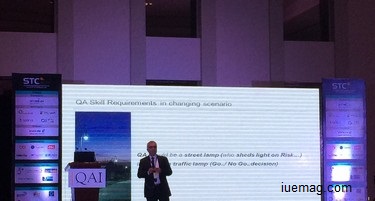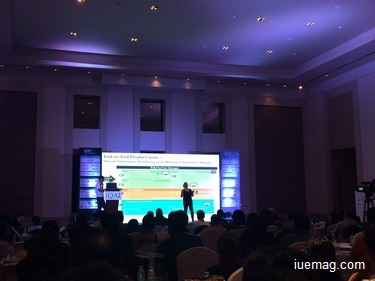

Special Features
A collection that's special to our readers, contributors and us especially for special news.

Ad
The 15th annual STC by QAI AND ETI: The takeaways of Day Two
Having witnessed brilliant papers presented on Day One of the STC, everybody came back with great expectations for the events that were to unfold on Day Two. Below are snippets of the best of the speeches by luminaries of the testing community, read on.
While Day Two saw a host of speakers adding more value to the testing world with their opinions on current testing trends, a few speakers stood out - Mr.Sridhar from Wipro, Mr.Shrini from Barclay's, Ms.Tal of Experitest, and Mr.Ajay Chhokra. Their views were holistic in approach, convergent rather than divergent, and insightful with regard to the tools available currently in the market for a variety of testing.

A. Mr.Chhokra
Mr.Ajay Chhokra spoke primarily about flexibility and agility to make the change happen. He stressed time and again that companies looked to hire great team players who could collaborate and work with the development team, the BA team, the SA team rather than individuals with great technical skills alone. He highlighted that the ability to learn quickly and to identify risks are two other important factors in today's world.
Ajay highly encouraged automation scripting as much as possible. "Manual testing scope for today still remains unaffected since automation is still in its infancy. But the big question we need to ask ourselves is whether manual testing will stay forever, and we really have no answer to that", he said.
Ajay concluded on a note that QA should be a street lamp (who sheds light on the risks) rather than be a traffic light (Go/ No Go decision). For all you QAs out there, take note!
B. Ms. Barmeir
Tal Barmeir, the CEO of Experitest shared her perspective of the mobile industry. She shared that leaving her mobile phone at home affects her daily life more than if she forgets her laptop. Also, she said that 60% of the online sales on Black Friday was done using the mobile. Considering they have 8 out of 10 banks associated with them. They have CI and full automation of the mobile apps.
A summary of the key points shared by Ms. Barmeir:
What is specific to Mobile QA?
Mr.Ajay Chhokra spoke primarily about flexibility and agility to make the change happen. He stressed time and again that companies looked to hire great team players who could collaborate and work with the development team, the BA team, the SA team rather than individuals with great technical skills alone. He highlighted that the ability to learn quickly and to identify risks are two other important factors in today's world.
Ajay highly encouraged automation scripting as much as possible. "Manual testing scope for today still remains unaffected since automation is still in its infancy. But the big question we need to ask ourselves is whether manual testing will stay forever, and we really have no answer to that", he said.
Ajay concluded on a note that QA should be a street lamp (who sheds light on the risks) rather than be a traffic light (Go/ No Go decision). For all you QAs out there, take note!
B. Ms. Barmeir
Tal Barmeir, the CEO of Experitest shared her perspective of the mobile industry. She shared that leaving her mobile phone at home affects her daily life more than if she forgets her laptop. Also, she said that 60% of the online sales on Black Friday was done using the mobile. Considering they have 8 out of 10 banks associated with them. They have CI and full automation of the mobile apps.
A summary of the key points shared by Ms. Barmeir:
What is specific to Mobile QA?

1. Scaling: Three years ago, mobile QA was in its infancy. The last 18 months has seen a rapid growth in mobile apps.
2. Running tests in parallel: Having thousands of devices with various OS, screen layouts and resolutions, parallel test runs save efforts and cost.
3. Implementing CI: Mobile app development is with very less time to market. CI is the only way to catch up.
4. Real life network conditions: In real life, the customer is entering tunnels, going down lifts and at these points if the mobile app goes down, impact is huge. So the necessity to test in real life
5. Layout testing: Visual presentation across various display screens and OS to check the layout appearance.
6. Peripheral set up testing.
7. Video and audio testing.
8. Decide management of distributed labs.
What Experitest offers:
1. See test automation - An automation tool the best part of which perhaps is the scripts can be exported to QTP, and the same test runs on different devices.
2. See test manual - Integrates to Jira and QC which helps dev team know the defects, mobile add-on for UFT (or QTP).
3. See test cloud - Device lab located onsite (access using VPN), the dev can use the device in debug mode to locate the issue. It is a user friendly application with access to data such as the availability of devices based on models, platforms, whether they are reserved, and the device usage history by the admin. The admin can control which user has access to which device based on his project.
C. Mr.Sridhar
Last in the list but actually the most impacting speech for the day (in at least my perspective) was of Mr.Sridhar from Wipro. An IIM grad student that he is, Mr.Sridhar provided a holistic view on testing rather than taking testing as an "independent" activity. He spoke at how mindful consciousness will take us a step closer if not miles, towards a product with better quality; and went on to add that this holds good for almost every aspect of life and is not limited just to testing. He asserted that only when we can look beyond credit or discredit that we may receive in the process can we truly add value to whatever we do. Pearls of wisdom raining aplenty, the audience had their fill.
2. Running tests in parallel: Having thousands of devices with various OS, screen layouts and resolutions, parallel test runs save efforts and cost.
3. Implementing CI: Mobile app development is with very less time to market. CI is the only way to catch up.
4. Real life network conditions: In real life, the customer is entering tunnels, going down lifts and at these points if the mobile app goes down, impact is huge. So the necessity to test in real life
5. Layout testing: Visual presentation across various display screens and OS to check the layout appearance.
6. Peripheral set up testing.
7. Video and audio testing.
8. Decide management of distributed labs.
What Experitest offers:
1. See test automation - An automation tool the best part of which perhaps is the scripts can be exported to QTP, and the same test runs on different devices.
2. See test manual - Integrates to Jira and QC which helps dev team know the defects, mobile add-on for UFT (or QTP).
3. See test cloud - Device lab located onsite (access using VPN), the dev can use the device in debug mode to locate the issue. It is a user friendly application with access to data such as the availability of devices based on models, platforms, whether they are reserved, and the device usage history by the admin. The admin can control which user has access to which device based on his project.
C. Mr.Sridhar
Last in the list but actually the most impacting speech for the day (in at least my perspective) was of Mr.Sridhar from Wipro. An IIM grad student that he is, Mr.Sridhar provided a holistic view on testing rather than taking testing as an "independent" activity. He spoke at how mindful consciousness will take us a step closer if not miles, towards a product with better quality; and went on to add that this holds good for almost every aspect of life and is not limited just to testing. He asserted that only when we can look beyond credit or discredit that we may receive in the process can we truly add value to whatever we do. Pearls of wisdom raining aplenty, the audience had their fill.
Get the Latest & Recommended articles in your Inbox
The event all in all was an eye-opener to all the testers, the leads, and the senior management who took part in the conference; with getting to learn about the emerging trends in the testing world. Automation testing is the future though GUI automation may not remain for too long, Manual testing is here to stay since it is literally impossible as of today to automate everything that needs to be tested, Agile methodology is still in its infancy and we are yet to see the industry adopt to Agile in its true spirit. All in all, the 15th annual STC connected testers across the industry and gave them a common platform to discuss the best practices followed and issues faced across companies, and was successful in connecting the testing community for the greater good. Here's to the entire testing community, to STC, and more importantly to QAI and ETI. Cheers.
Copyrights © 2024 Inspiration Unlimited eMagazine
Any facts, figures or references stated here are made by the author & don't reflect the endorsement of iU at all times unless otherwise drafted by official staff at iU. This article was first published here on 5th December 2015.



